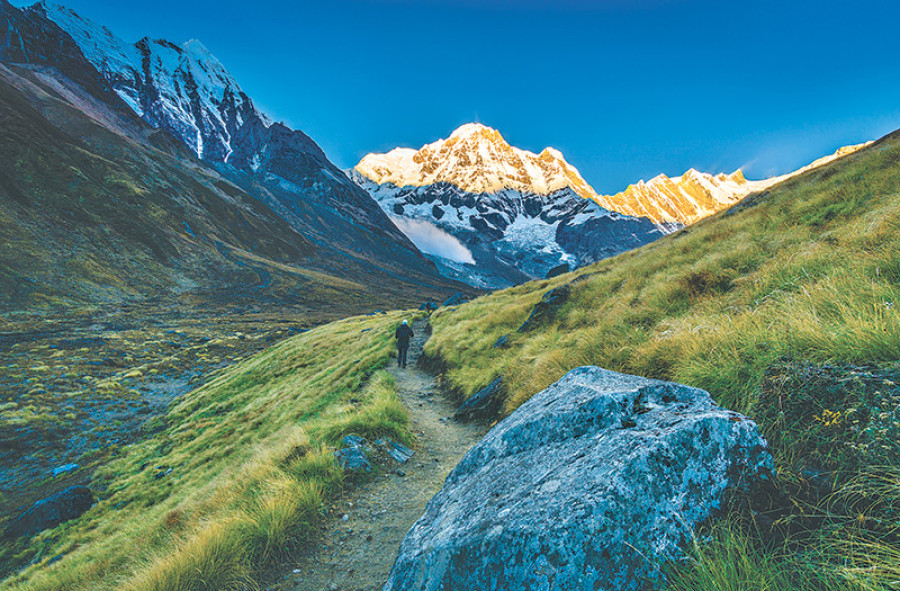Miscellaneous
The mountains are calling, but not you
On a chilly October evening, following a day of arduous trekking, we reached a popular hotel in the famous tourist hub of Ghandruk. The snow-clad mountains were barely visible as the sun had already set beyond the western horizon.
Shreya Paudel
On a chilly October evening, following a day of arduous trekking, we reached a popular hotel in the famous tourist hub of Ghandruk. The snow-clad mountains were barely visible as the sun had already set beyond the western horizon. My British companion and I stood on the hotel veranda, listening to our Nepali guide as he asked for two separate rooms for his guests. The hotel owner agreed at first and showed my friend his room. But as soon as she saw that I was the other guest, the image of a ‘guest’ in her mind could not accept me. “No, we don’t have rooms left. Other ‘guests’ could be coming in later in the evening,” she told us, matter-of-factly.
Clearly, there were rooms available but the owner did not want a Nepali guest in her hotel. It was cold outside and I did not know where else I could stay if not for this hotel. More than that, I could not understand how a Nepali hotel owner could flatly reject a Nepali customer just because he is a Nepali. Keeping my frustration and anger at bay, I negotiated with her and offered to pay the same amount as a foreigner. The amount she was looking for was seven hundred rupees, a relatively partly sum. We struck a deal.
That night, I was able to escape Ghandruk’s cold but I could not shake off the cold contempt for a fellow Nepali that I saw in the hotel owner’s eyes. She had not even considered that I would be able to pay what she hoped to make from a foreign tourist. Though I had recently gone through some challenging experiences of being a brown, Asian foreigner in an increasingly xenophobic Europe, going through such an awful experience that bordered racism in one’s own country was not what I had expected as a Nepali tourist. I can only imagine what Madhesis or Dalits or Chepangs have to put up with in their everyday lives when they have to encounter the Nepali state and its apparatuses that favour the dominant community. The humiliation must be excruciatingly painful. As a privileged urban, hilly Bahun man in Nepal, this trek was probably the first time I had experienced discrimination on the basis of my identity in Nepal, as a Nepali national.
And this was not a one-off experience where one, cranky hotel owner was being particularly difficult. This seemed to be a loose norm in the trekking route as confirmed to me by other Nepali tourists—hotel owners, at best, hesitate to give Nepalis rooms during the night and, at worst, flatly reject us as their guests. This discrimination here is not based on any Nepali ethnicity. A Nepali from any ethnicity could have been there and they would have faced the same trouble getting rooms.
It seemed as if a significant portion of hotel owners, travel agencies and the tourism sector in general are oblivious to the spending capacity of middle-class Nepalis. People are increasingly wanting to spend their expendable income to see and experience Nepal as domestic tourists. Sooner than later, more and more Nepalis are likely to visit Manangs and Mustangs of the country, which until now have only been a destination for foreign tourists. Similarly, they are also likely to go to Pathivaras, Muktinaths and Lumbinis, seen as important in Nepali religious and cultural context. According to an article in The Kathmandu Post last year, there were 1,800 domestic visitors only in the month of October in Mustang. Rara Lake in Mugu saw 300 Nepali visitors every day during Dashain of 2016.
As it is clear that the number of Nepali tourists is already burgeoning, tourism entrepreneurs should not be reluctant to welcome them. Ideally, the tourism market should largely care about what customers demand and what producers can supply. The nefarious practice of discriminating customers on the basis of their caste, colour, religion, nationality and gender is against human decency and the logic of the market. It is true that Nepal Tourism Board declared 2073 BS as the ‘Ghumfir Barsha 2073’ (Travel Year 2073) to attract domestic tourists. That is a praiseworthy start. However, the industry will now have to work hard to tailor its services to Nepali tourists’ needs, and implement a policy to treat them as equals to their foreign counterparts. This will be crucial if tourism industry is to tap into growing Nepali aspiration to explore Nepal’s natural splendour, not just in the fall and spring seasons like foreign tourists, but throughout the year.
The next morning when we were checking out from the hotel in Ghandruk, I insisted to my British friend that I would be paying for our combined bill. I did that thinking the hotel owner for once would re-think her behaviour towards future Nepali trekkers. However, as this is more than a single hotel owner’s issue—the tourism industry needs to find ways of educating its entrepreneurs to shed-off their biased mentality towards Nepali travellers.
After returning from the trek, I could not help but fall in love again with Nepal’s natural beauty. But I was not sure if I wanted to go through the experience of being second-class tourist in my own country. The mountains might be calling, but it is clear that at least for now, that call is not aimed for those who look like you or me.




 13.12°C Kathmandu
13.12°C Kathmandu










